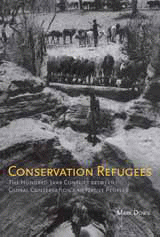SEJournal Online is the digital news magazine of the Society of Environmental Journalists. Learn more about SEJournal Online, including submission, subscription and advertising information.

BookShelf
Conservation Refugees: The Hundred-Year Conflict between Global Conservation and Native Peoples
By Mark Dowie
MIT Press, $27.95
Reviewed by TERRI HANSEN
What is wilderness?
The 1964 Wilderness Act describes it as "an area where the earth and its community of life are untrammeled by man, where man himself is a visitor who does not remain." Indigenous cultures isolated from Judeo-Christian influence have no word for wilderness; it is simply 'what is,' their home, not some area beyond their community.
There lies the conflict.
In Conservation Refugees: The Hundred-Year Conflict between Global Conservation and Native Peoples, investigative historian and journalist Mark Dowie follows the history of ecological preservation since the early 1900s that has seen the establishment of more than 108,000 officially protected conservation areas worldwide, and the expulsion of millions of indigenous people from their homelands.
Dowie doesn't point to conservationists as the bad guys. Indeed, as he says at the beginning of this provocative and sometimes haunting book, "What you are about to read is a good guy versus good guy story."
Both movements — of conservationists and indigenous peoples — care deeply about the planet, he writes. Together they are capable of preserving more biological diversity than any other two institutions. Yet they have been at odds, sometimes violently, due to conflicting views of nature, radically different definitions of wilderness, and profound misunderstandings of each other's perspectives on science and culture.
His story begins with the creation of Yosemite National Park. Its mystique was created by photographers like Ansel Adams who knowingly left out its inhabitants or any signs of them in their images. Adams and his friends sought to preserve an idealized version of nature called 'wilderness,' a place humans had explored but never touched. "It was the beginning of a myth," writes Dowie, "a fiction that would gradually spread around the world, and for a century or more drive the conservation agenda of mankind."
John Muir emerges as a complicated figure who lobbied to evict the Miwoks and other tribes that had lived in Yosemite's valleys for 4,000 years. Revolted by the Indians, he asked that they be removed, and they were; it fueled California's war of extermination.
Muir's vision of wilderness — a pristine area cleared of all human inhabitants and set aside for recreation and fulfillment of the urbane human's need for spiritual renewal — laid the foundation for the exclusionary model of wilderness preservation.
The Yosemite model spread to seven other national parks and beyond America to Australia, Canada, New Zealand, then Europe, which created remarkably similar parks — clearing out the natives so colonials could enjoy the aesthetics of wild nature, and in Africa, selectively hunt the game for trophies. This philosophy guided the big conservation BINGOs — Big International NGOs, such as the Worldwide Fund for Nature, Conservation International, and The Nature Conservancy. Dowie commends such groups for recent pledges to involve indigenous peoples in the establishment and management of protected areas in ways that respect their traditional knowledge and self-determination. But he cites conservationists' complicity by silence as national governments violate the rights of indigenous peoples when creating new protected areas. He describes the experiences of other indigenous cultures; the Ogiek and Maasai hunters of the Serengeti, the Pygmies of Central Africa, the Adivasi people of India's forests, and the Karen of Thailand, all evicted or severely limited from using their land once it was declared a park or a reserve. Whole societies who had lived on those lands for hundreds or thousands of years slid into poverty. Living in squalor or on the lowest rungs of the economy, some have turned to illegal poaching on their former homelands. Some face extinction.
Dowie doesn't romanticize the lifestyles of indigenous peoples. Not all indigenous peoples are perfect land stewards, he writes. But he argues their "traditional ecological knowledge" or TEK— the collection of botanical, zoological, hydrological, cultural, and geographical know-how that is rooted in spirit, culture and language, and the fact that ancient societies have been found living in biodiverse habitats for millennia, are indicators that sound TEK principles work. He discusses the need for native peoples and Western science to integrate traditional knowledge with modern ecology, to acknowledge the interdependence of biodiversity conservation and cultural survival. He endorses a conservation model that allows indigenous people to stay inside conservation areas, and involves them in conserving resources — no commercial hunting or logging, for example.
True ecological conservation requires balancing both interests. Together, they can create a new and much more effective model for conservation. "If we really want people to live in harmony with nature, history is showing us that the dumbest thing we can do is kick them out of it," writes Dowie.
Terri Hansen is a freelance journalist and longtime SEJ member. She is Indian Country Today's environment and health correspondent.
** From SEJ's quarterly newsletter SEJournal, Winter 2009-10 issue










 Advertisement
Advertisement 


